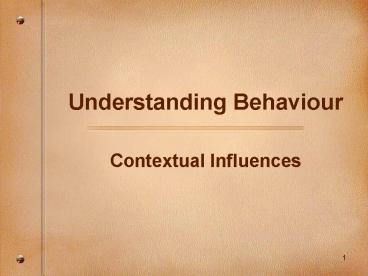Understanding Behaviour - PowerPoint PPT Presentation
Title: Understanding Behaviour
1
Understanding Behaviour
- Contextual Influences
2
Getting re-connected
- Activity
- Honoring Differences
3
Ecological considerations
- Refers to the environment in which the student is
learning - Classroom environment
- Schedules rules
- Room arrangement for instruction and materials
management - Student seating arrangements
- Plans for transition between activities and
settings - Curricular and instructional approaches
4
Classroom rules
- Promote consistency and structure
- School wide
- Classroom schedule
- Individual student schedules
- Classroom rules
5
Room arrangement
- Maximize ability to monitor students
- Decrease noise and disruption
- Increase students on-task behaviour
- Minimize distractions
- Encourage students to interact with each other
and the educators - Allow students easy access to materials
6
Student Seating Arrangements
- Proximity to teacher
- Proximity to other students
- Proximity to distractions
- Instructional formats
- Individual
- Large Group
- Cooperative
7
Transitions
- Develop consistent transitions
- Give notice before the transition must be made
- Review individual schedules after each activity
or period - Organize materials for activities and make them
accessible - Support students with desk and binder organization
8
Curricular Instructional Approaches
- Use multiple modalities
- Conduct personal profile
- Implement differentiated instruction approaches
determining what to teach, how information is
presented and how students show their learning.
9
Curricular Instructional Approaches
- Adapt and / or modify curriculum
- Change amount of work or time
- Change the appearance of assignments
- Pace instruction
- Provide an alternative time to complete
assignments
10
Curricular Instructional Approaches
- Adapt and / or modify curriculum
- Change difficulty (and still keep the same
outcome for the activity) - Change form of output
- Provide peer support
11
Adaptive Devices
12
Design Formatting
13
Interactive Style
- Consider your
- Tone of voice
- Body posture
- Belief in student
- Language to describe student and to give
instructions - Use of control
14
Interactive Style
15
Authoritarinism
- Attitude characterized by
- I am here to teach you the rule
- Compliance is the typical form of interaction
- Focus on learning what not to do, rather than
what to do
16
Coldness
- Attitude characterized by
- Minimal interaction
- Basic custodial care (providing food, shelter)
- Its just a job, a routine to get through
- Little belief in the student and their abilities
17
Overprotection
- Attitude characterized by
- Implied warmth but really its pity and minimal
expectations - Fosters dependency
- The educator often resolves each difficulty
(doing the work for the student, denying them the
opportunity to learn and develop - even if it
means making mistakes)
18
Solidarity
- Attitude characterized by
- Respect for the student
- Safety and rules are accomplished without
smothering or excessive control - Focus is on development of the learner and
educator
19
Functional Behaviour Assessment Steps
- Decide if a intervention is warranted
- Develop a personal profile
- Define the target behaviour
- Conduct a functional behaviour interview
- Conduct direct observations
- Use setting events checklist
- Form hypothesis
- Design an support plan (prevent, teach and
respond) - Evaluate plan
20
Shaping Up a Review
- What are some things you heard that squared with
your beliefs? - What questions are still going around in your
head? - What are 3 points you want to remember?
21
A simplified way of framing the assessment and
intervention process
Antecedent Behaviour Consequence
Proactive Teach Response
You the student
22
Things to try for next time
- Bring in an example of a visual tool you use in
your own life































